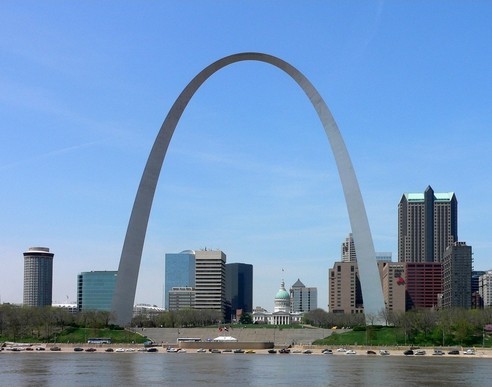Americana: Missouri
24 Nov - 05 Dec 2009
AMERICANA: MISSOURI
A Monument to Expansion
Mary Augustine Gallery | Nov. 24–Dec. 5, 2009
Missouri has a reputation for being the "Bellwether" state, a perfect sampling of the nation in its political values. Located in the geographic center of the country, Missourians have good reason to consider themselves as representative of America's heart. Bound up in that image is the state's historical connection to American expansion. St. Louis was the departing point for the 1804 Louis and Clark expedition and, 123 years later, the aircraft Spirit of Saint Louis would represent another kind of expansion, this time transatlantic. Among the plaques and monuments commemorating such American journeys, the memorial most often connected with Missouri is the Gateway Arch in Saint Louis.
One of the most recognizable monuments in America, the Gateway Arch was built as part of the Jefferson National Expansion Memorial, a site consisting of a 91-acre park along the Mississippi River. The design for the monument was determined through a national competition in 1947, which drew entries from the leading architects and designers from across the country. Asked to create a memorial that symbolized St. Louis' role as a 'Gateway to the West' over 172 designers, firms, and groups submitted their ideas to the selection committee, who eventually chose Eero Saarinen's Gateway Arch proposal to represent the site.
Despite having drawn submissions from many of the best-known architects of the era, only one design was chosen for the memorial project. So what happened to the 171 other proposals? What place does history reserve for the also-rans of American monuments? Through their scale and design monuments help form how communities interact with the past. More than just a physical reminder of past events, they elevate history to the status of modern mythology. In this way monuments become the official record of popular history, offering a single narrative as a stand in for the larger story.
With so much popular and scholarly attention given to the Gateway Arch, much can be gained by looking at what the selection panel decided not to build. These never-realized plans represent a collection of artistic visions that did not match up to the desires of people who control production, and in their own way, they tell the story of an alternate America.
Working from the diagrams and descriptions of the un-built Jefferson Memorial proposals, Bay Area artist Sash Petrenko has designed alternative monuments to symbolize America's expansionist ideals. Her work is a reminder of how memorials shape the historical events they ostensibly represent.
Curated by Josephine Zarkovich
A Monument to Expansion
Mary Augustine Gallery | Nov. 24–Dec. 5, 2009
Missouri has a reputation for being the "Bellwether" state, a perfect sampling of the nation in its political values. Located in the geographic center of the country, Missourians have good reason to consider themselves as representative of America's heart. Bound up in that image is the state's historical connection to American expansion. St. Louis was the departing point for the 1804 Louis and Clark expedition and, 123 years later, the aircraft Spirit of Saint Louis would represent another kind of expansion, this time transatlantic. Among the plaques and monuments commemorating such American journeys, the memorial most often connected with Missouri is the Gateway Arch in Saint Louis.
One of the most recognizable monuments in America, the Gateway Arch was built as part of the Jefferson National Expansion Memorial, a site consisting of a 91-acre park along the Mississippi River. The design for the monument was determined through a national competition in 1947, which drew entries from the leading architects and designers from across the country. Asked to create a memorial that symbolized St. Louis' role as a 'Gateway to the West' over 172 designers, firms, and groups submitted their ideas to the selection committee, who eventually chose Eero Saarinen's Gateway Arch proposal to represent the site.
Despite having drawn submissions from many of the best-known architects of the era, only one design was chosen for the memorial project. So what happened to the 171 other proposals? What place does history reserve for the also-rans of American monuments? Through their scale and design monuments help form how communities interact with the past. More than just a physical reminder of past events, they elevate history to the status of modern mythology. In this way monuments become the official record of popular history, offering a single narrative as a stand in for the larger story.
With so much popular and scholarly attention given to the Gateway Arch, much can be gained by looking at what the selection panel decided not to build. These never-realized plans represent a collection of artistic visions that did not match up to the desires of people who control production, and in their own way, they tell the story of an alternate America.
Working from the diagrams and descriptions of the un-built Jefferson Memorial proposals, Bay Area artist Sash Petrenko has designed alternative monuments to symbolize America's expansionist ideals. Her work is a reminder of how memorials shape the historical events they ostensibly represent.
Curated by Josephine Zarkovich

